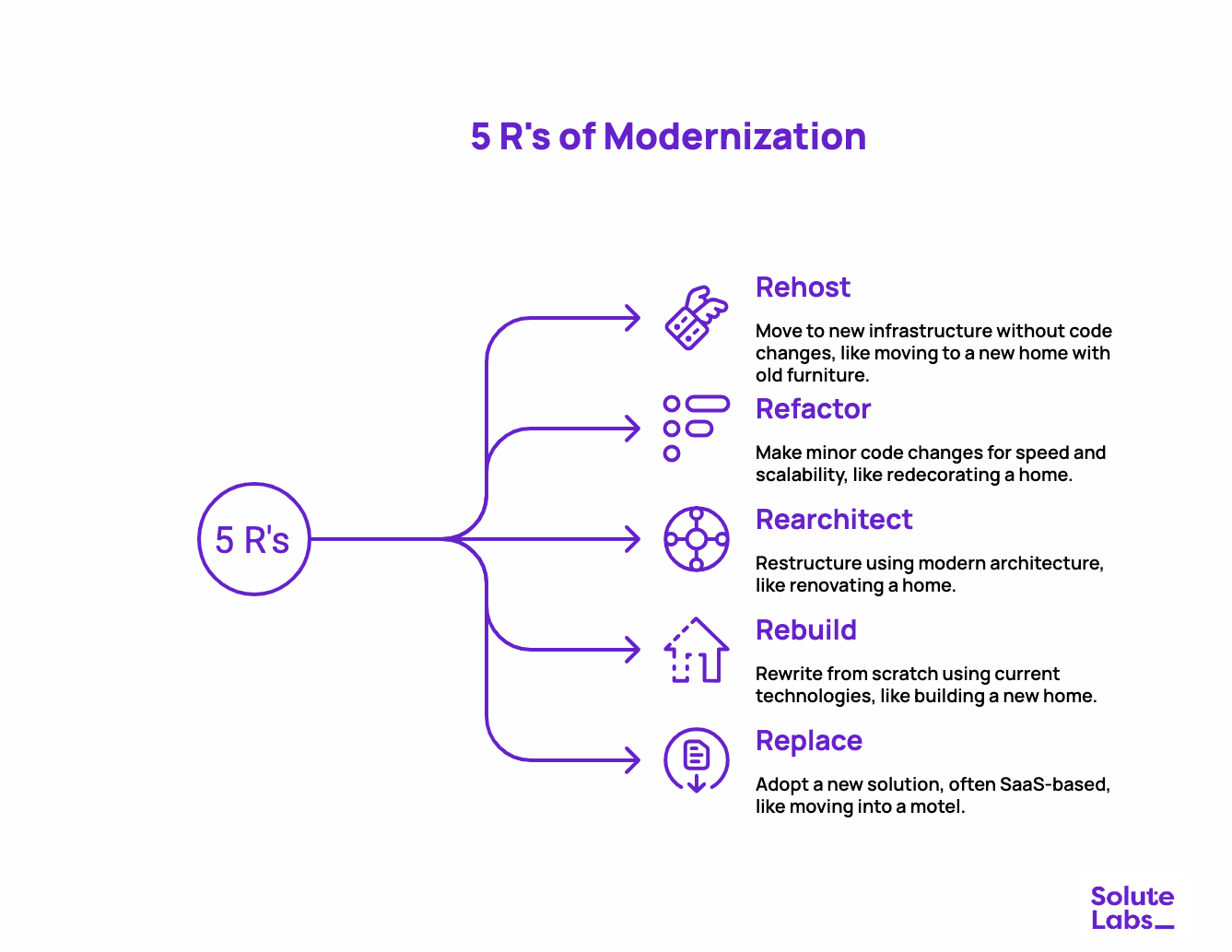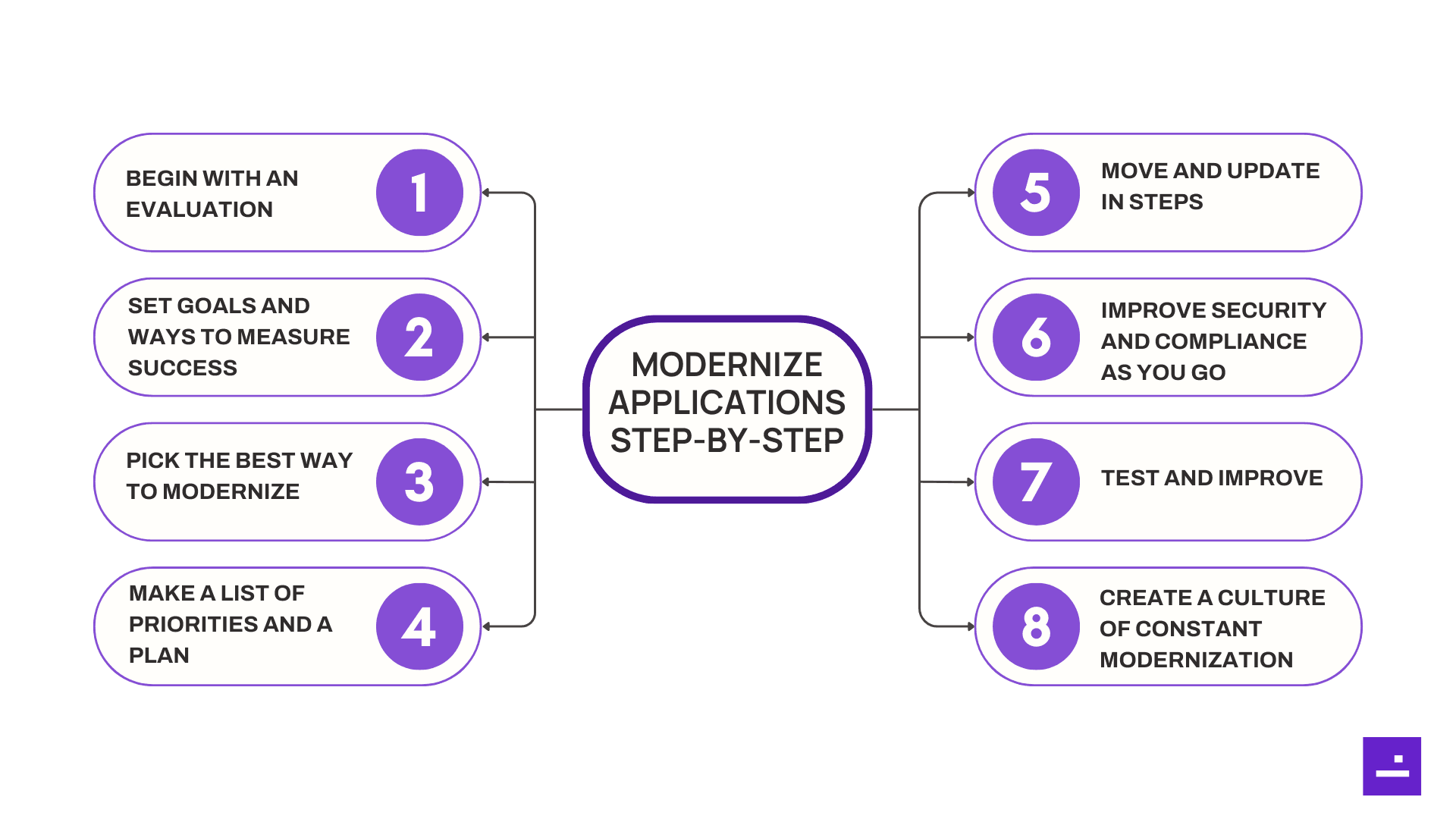Consider how many tools and systems your organization relies on every day. Consider that half of them are operating on technology developed 15-20 years ago. Sounds hazardous, right? That is the reality for many firms today. According to a recent source, organizations still spend 60 – 80 % of their IT budgets just maintaining those old systems, not building new things that actually move the business forward..
This is where application modernization comes in. It's more than simply making applications look nice with a new design; it's about rethinking, updating, and restructuring existing software to meet contemporary consumer expectations, security considerations, and scalability demands.
We'll talk all about app modernization, what AI in app modernization means, why it matters, the various methods, and some practical tactics. By the conclusion, you'll understand not just why modernization is important, but also how to approach it in a manner that is effective for your firm. So, without any further ado, let’s get started!
What is Application Modernization Exactly?
Application modernization extends well beyond regular maintenance and updates. It's a basic change in the way you treat legacy applications, transforming them into adaptive, cloud-enabled solutions with the latest application modernization tools. Modernization has progressed with advancements in technology. Application modernization methodologies may differ from decoupling monolithic systems into independent microservices to embracing containerization and cloud deployments. It can involve the use of advanced technology like artificial intelligence or serverless architecture to offer new features that the business requires but cannot implement through the application in its current state.
Application modernization does not stop at the code itself. It touches every aspect of the application lifecycle. This involves taking a look at your development practices, such as DevOps concepts, and getting the firm and existing apps ready for ongoing improvement and innovation. Although application modernization can be a huge undertaking, it usually qualifies as an investment as opposed to an expense. Effective modernization efforts make the firm more agile, decrease technology debt, and give a company a competitive advantage.
What is the Need for Application Modernization?
An application modernization solution is essential, and for technology-driven firms, it is imperative to remain relevant. Historically vital to operations, legacy programs may become considerable liabilities if their present condition hinders innovation and necessitates extensive upkeep. Executing a comprehensive application modernization plan helps alleviate these challenges. Legacy applications may impede organizational progress and may indicate the need for application modernization.
1. Technical Debt
Old systems often have a lot of inefficient structures, complicated dependencies, and outdated ways of developing software. Because of this technological debt, making changes is slow, expensive, and likely to have unexpected effects. This is the main thing that stops most companies from being able to come up with new ideas.
2. Limits on Agility
Monolithic systems and inflexible deployment methods make even small changes hard to make. Because of this, businesses can't quickly adjust to changes in the market, customer needs, or new opportunities.
3. Threats to Security
Obsolete apps may have recognized vulnerabilities or lack actively maintained dependencies. This renders firms vulnerable to cyberattacks, potentially leading to data breaches, operational disruption, and reputational harm.
4. Challenges of Scalability
Legacy systems often have difficulties in managing heightened traffic, data expansion, or additional functionalities. This may result in bottlenecks, aggravating user experiences, and missed income possibilities. Scalability is often achievable, but at an escalating cost. This transitions to our subsequent argument on elevated expenses.
5. Escalating Expenses
The maintenance of obsolete software may substantially deplete resources. As applications mature or need scaling, enterprises may encounter escalating infrastructure expenses and reliance on costly legacy providers. Locating developers with the requisite expertise to sustain outdated technology is becoming more challenging and expensive.
Upon completion, app modernization seeks to mitigate these challenges. A successful modernization initiative will render the firm more nimble, secure, and cost-efficient.
What are Some of the Best Benefits of App Modernization?
Upgrading obsolete systems is more than simply a "tech refresh"; it affects the whole business. Here's what organizations often observe following modernization:
- Improved Performance and Scaleability: Programs respond fast and can support a higher number of users without failing. Companies can expand without concern for system bottlenecks.
- Reduced Operational Costs: Migration to the cloud or modern infrastructure reduces maintenance costs. Old support contracts are expensive; modernization reduces or eliminates them.
- Improved Security: There are built-in protections in contemporary frameworks. Vulnerabilities are simpler to repair and stay in regulations.
- Enhanced Customer Experience: Clients stay engaged due to intuitive interfaces, faster response times, and mobile-friendly layouts.
- Innovation Support: It is simple to incorporate AI, automation, and analytics with today's APIs and cloud services.
In short, modernization is more of an IT enablement tool than a mere IT overhaul. It helps businesses to grow, evolve, and compete in an ever-evolving marketplace.
5 R’s of Modernization

The "R's" framework is a common approach to application modernization. You'll hear several permutations: 5 R's, 6 R's, and even 7 R's, but the concept remains the same: diverse modernization tactics dependent on your requirements.
Here's a breakdown:
- Rehost (Lift and Shift): Move the program to a newer infrastructure (typically the cloud) without modifying the code.
- Refactor: Make minor modifications to increase speed and scalability without completely rewriting.
- Rearchitect: Restructure the software using a contemporary architecture, such as microservices.
- Rebuild: Use current technologies to completely rewrite the program from scratch.
- Replace: Discard the old program in favor of a new solution, which is generally SaaS-based.
Consider this: rehosting is similar to moving into a new home with all of your old furnishings. Refactoring entails redecorating. Rearchitecting means renovating. Rebuilding means starting from zero. Replacing means selling the home and moving into a motel.
Other Common Patterns of Modernization
In addition to the aforementioned alternative, several additional prevalent patterns may be used for cloud-native application modernization. The following are among the most popular.
1. Incremental Modernization (The "Strangler Fig" Paradigm)
Gradually dismantle your monolithic application by methodically substituting its components with new, often microservice-oriented, implementations. Legacy and contemporary systems function together, facilitating a regulated, risk-mitigated transition.
2. Containerization
Containerization wraps applications and their dependencies into self-sufficient entities, often using technologies such as Docker and Kubernetes. These containers operate consistently across many contexts, enhancing portability, application scalability, and deployment efficacy. This design is highly conducive to cloud migration.
3. Event-Driven Architectures
Applications structured on event-driven architectures respond to events instantaneously. Technologies like as message queues and streaming platforms facilitate this, enhancing scalability and robustness while diminishing tight connections among various components of your system.
In several instances, the modernization of real-world applications entails the purposeful integration of various patterns. Commencing with modest initiatives and expanding upon early achievements may demonstrate value and secure organizational endorsement for your modernization strategy. To understand the specifics of this process, we will examine essential components of an effective application modernization approach.
Legacy System Modernization Strategies
As previously said, adopting a successful application modernization strategy needs careful planning and implementation. Tailored Java and .NET modernization techniques may help to speed up the process by addressing the unique requirements of these popular platforms. With this in mind, let's look at some key application modernization tactics for streamlining the process and maximizing your results.
1. Begin With a Comprehensive Examination
Before attempting to update existing applications, undertake a thorough examination of your current application ecosystem. Examine individual apps, including their architecture, dependencies, code quality, and fit with your current business requirements. This evaluation will identify the most urgent issues and assist you in strategically prioritizing the path to your desired outcome.
2. Define Clear Objectives
Explain the exact reasons for your modernization project. Are you looking for more agility, lower costs, greater scalability, a better user experience, or a mix of these? Having well-defined objectives keeps your modernization initiatives on track and allows for efficient progress tracking.
3. Plan for Modest Changes
Avoid disruptive, "big bang" modernization initiatives wherever feasible. Instead, divide the work into doable steps. Determine whether functional components of the application may be upgraded individually. This iterative method is the most effective way to reduce risk and achieve early victories. It also helps to foster a culture and structure for continual development.
4. Choose the Appropriate Technology
The success of modernization depends on making the proper technological choices. Examine cloud services (including hybrid and private cloud options), containerization software and technologies, microservice architectures, DevOps toolchains, and current software frameworks. Choose the tools and paradigms that are consistent with your long-term vision and support the features you want to develop.
5. Invest in Your Staff Members
Your development team must adopt new skills and methodologies as part of the modernization process. Organizations must give chances for training and upskilling, ensuring that their workforce can properly exploit any new technology they introduce.
6. Emphasize Security From the Beginning
Security must be a primary concern throughout your modernization initiatives and a key emphasis from the start. Implement current security frameworks and procedures (such as the "shift-left" testing approach), encourage safe coding standards, and make full use of any cloud-native security capabilities provided by your platform of choice.
While common software development concepts apply, app modernization often takes advantage of a more specialized approach. Techniques such as domain-driven design (DDD) and continuous code reworking are useful for understanding, decomposing, and iteratively modernizing big, complicated legacy systems. A successful modernization journey requires proper planning, either from a technological roadmap or from human resources.
Key Technologies Driving Application Modernization
In the migration from legacy systems, it is imperative to adopt the proper set of contemporary technology. As companies shift away from legacy frameworks and on-premise setups, these technologies and methodologies might have a vital part in simplifying the process of modernization and making it more productive.
1. Cloud Computing
Cloud services, be it Infrastructure-as-a-Service (IaaS), Platform-as-a-Service (PaaS), or Software-as-a-Service (SaaS), offer scalability, flexibility, and managed services that significantly cut down on the task of handling traditional infrastructure. Businesses that adopt cloud migration tend to have reduced expenses, faster rollouts, and access to ongoing developments without the limitations of traditional data centers.
2. Containers
Container platforms like Docker and Kubernetes are now a necessity for modern application deployment. Containers bring consistency in environments, ease deployment, and make coordinating complex programs much simpler. They also facilitate microservices-based architectures, enabling teams to build and expand modularly.
3. Microservices
Segregating monolithic systems into lower-layered, independent services enhances fault tolerance and flexibility. Every microservice can be updated, released, or scaled separately, reducing the risk of system interruption and making it easier to adapt to changing business requirements.
4. DevOps Practices and Toolchains
DevOps practices, in addition to CI/CD pipelines, infrastructure as code (IaC), and configuration management tools, reduce the release cycle and overall dependability. DevOps allows teams to deliver updates continuously and at scale by eliminating the silos between development and operations, which is a key enabler for modernization.
5. Cloud-Native Data Solutions
Redesigning data management is as important as app upgrades. Distributed warehouses, data lakes, and high-performance databases are some of the cloud-native options that are designed for massive workloads. They form the basis for analytics and help enterprises tap their enhanced application ecosystems to the fullest.
6. Artificial Intelligence (AI) and Machine Learning (ML)
The blend of AI and ML brings automation, better analytics, and personalization in applications. The technologies bring business value through individualized customer experiences and improved predictive capabilities. The developers can further make their development more productive using AI-assisted coding tools like GitHub Copilot to reduce cycles and remove routine tasks.
Finally, selecting the appropriate tools and processes is a commercial choice rather than a technical one. The ideal balance should reflect your organization's objectives, the complexity of the applications being converted, and your team's experience. When correctly connected, these technologies guarantee that modernization expenditures provide real, long-term benefits.
How Can You Modernize Applications Step by Step?

At first glance, updating applications can seem like a lot of work. A lot of companies are afraid to modernize because they think it will be an all-or-nothing process. But the truth is that modernization works best when it is done in clear, manageable steps over time. Instead of tearing down a building, think of it as carefully fixing it up while people are still living there.
Here's a useful step-by-step application modernization guide for businesses to follow:
1. Begin With an Evaluation
You need to really understand what you have before you make any changes. This means checking your current applications, infrastructure, dependencies, and business processes. What apps are essential to the mission? Which ones are stopping you? This stage is all about being seen and making decisions about what's most important.
2. Set Goals and Ways to Measure Success
You don't have to start over with every system. Modernization should be linked to business goals like getting products to market faster, making customers happier, or lowering maintenance costs. You won't waste time if you set clear goals and say how success will be measured. For example, you could say that downtime will go down by 30% or infrastructure costs will go down by half.
3. Pick the Best Way to Modernize
This is where strategies like rehosting (lifting and shifting), re-platforming, refactoring, or rebuilding come in. Some apps only need small changes, while others need a whole new architecture. The "R's of modernization" (which we'll talk about later in the blog) are like a menu; the hard part is picking the right one for each app.
4. Make a List of Priorities and a Plan
It costs a lot of money and is risky to try to modernize everything at once. Instead, figure out which apps will bring the most value to your business when they are updated. Make a phased plan. Start with a small pilot project, show quick wins, and then grow. This makes it easier for teams to work together and get things done.
5. Move and Update in Steps
Now it's time to get to work: moving apps to new environments. Moving to the cloud, containerizing workloads, or breaking monoliths into microservices should all be done in steps. Modernization isn't something that happens all at once; it's a series of smaller, planned changes.
6. Improve Security and Compliance as You Go
One step that is often missed is to use modern security methods at every stage. Modernization is a chance to make your defenses stronger, not just improve performance. For example, you can use zero-trust architecture or make sure you follow standards like HIPAA or GDPR.
7. Test and Improve
Once applications are up and running in their new form, it's very important to keep an eye on them all the time. To see how well you're doing compared to your goals, use analytics and feedback loops. Are the systems working faster? Are users noticing any changes? Make changes based on what you've learned to improve even more.
8. Create a Culture of Constant Modernization
Finally, the process shouldn't end with the first rollout. When teams stop growing, legacy creep happens. When you create a DevOps-driven culture, encourage ongoing learning, and regularly check on your systems, modernization becomes a way of life instead of a one-time project.
Use Cases of Application Modernization
Updating your applications isn't just a tech upgrade; it also helps your business. Here are some real-life application modernization use cases:
- Better Customer Experience: Banks, stores, and service providers use APIs and microservices to update their apps so that they work better on mobile devices and offer more personalized experiences.
- Scalability During High Demand: eCommerce platforms move to the cloud so they can handle traffic like Black Friday without crashing.
- Lower Costs: Old systems eat up IT budgets. Moving to SaaS or cloud-based platforms cuts down on maintenance and licensing costs.
- Stronger Security and Compliance: Modernized apps come with encryption, monitoring, and compliance-ready frameworks, which are especially important in fields like healthcare.
- Better Use of Data: Upgraded systems get rid of silos, which lets you use AI and real-time analytics to make better decisions.
- Faster Innovation: With microservices and CI/CD, companies can add new features in weeks instead of months.
What Future Trends Will Shape Application Modernization?
A combination of AI-native cloud and DevOps adoption and a stronger focus on security will drive application modernization in the future. Businesses are slowly moving toward serverless architectures, edge computing, and low-code platforms that make it easier and faster to modernize. At the same time, AI and machine learning are expected to be used more to automate tasks, make developers more productive, and power smart apps that adapt to meet user needs in real time.
The growing importance of compliance and sustainability is another trend that will shape the future. Companies are picking cloud providers and ways to modernize that use less energy and still meet stricter rules for data around the world. The rise of hybrid and multi-cloud strategies shows that modernization isn't just about keeping up with new technology. It's also about making systems that can adapt and thrive in a digital economy that changes quickly.
The Bottom Line
Application modernization is no longer a choice; it's the only way to stay relevant in a world that moves quickly. Modernization lets businesses come up with new ideas, grow, and give their customers better experiences by moving away from old systems, using cloud-native solutions, or finding new ways to use data. When done correctly, it lowers costs, makes security stronger, and lays the groundwork for future growth.
At SoluteLabs, we help businesses through this change by combining technical know-how with a focus on business. Our team makes sure that modernization fits with your goals, not just the latest technology trends. We do things like evaluate legacy systems, make cloud-native apps, and add AI. SoluteLabs can help you upgrade your apps with the least amount of risk and the most impact. Contact us today!







